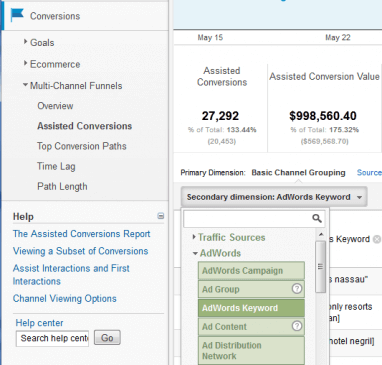Often, while managing AdWords campaigns, I run into keywords that I believe are highly relevant and I just cannot get the buggers to convert no matter what I try. If you’ve done any amount of pay-per-click ads management in your career (regardless of the engine), I’m sure you’ve run into this issue as well.
What do you do with these keywords? Do you just pause or delete them and call it a day? Not me. I’m a keyword optimist and I want to exhaust all of my options before killing a keyword, especially if it’s a highly relevant keyword that should be providing a return. So when I run into this problem, I call on the brilliance of the Digital Intelligence team here at Cardinal Path. That’s right folks, here at CP I’ve got a full Digital Intelligence team behind me. These data whisperers have shown me tons of cool tricks over the years and here’s a new one, Google Analytics Multi-Channel Funnel reports. Yes, it’s a mouthful, but as we’ll see, it’s essential for accurately measuring the value of AdWords traffic.
To illustrate the benefit of MCF, let’s have one of those data whisperers, Nick Iyengar, take us through an extremely common scenario.
Scenario: You learn from AdWords or Google Analytics that a certain group of keywords is generating a low conversion rate on your site. As such, your instinct tells you to either lower the bids on these keywords or stop running them entirely. An entirely reasonable reaction!
But let’s ask a simple question. Does a low conversion rate necessarily mean that a given keyword has little value to you? Again, our instinct might tell us that yes – a low conversion rate means a low-value keyword. However, what if a keyword generates a lot of assists without generating many conversions? If that were true, the keyword would in fact be valuable – and it would be a mistake to stop investing in that traffic! Let’s see how MCF can help us verify that keywords with low conversions are truly low-value.
Step 1:
Normally, you would probably use the AdWords Keywords report in Google Analytics to evaluate keyword performance. If you were to create an advanced filter, you could easily generate a list of keywords that cost a certain amount of money, but don’t return many conversions. Let’s call this group of keywords our “suspected low performers” (SLPs), and export the keywords and their performance data out to Excel.
Step 2:
Next, let’s choose the “Assisted Conversions” report and select “AdWords Keyword” as our dimension. The metric on the right – Assisted Conversion Value – will give us the key insight we need. Using another advanced filter, let’s try to find those SLPs once again. It’s OK if you end up with a slightly different list of keywords – either way, you’re going to dump those into Excel as well (in a new tab/worksheet).

Step 3:
So far you should have an Excel spreadsheet with two worksheets. One should have the standard conversion metrics for your suspected low performers, and the other should have the assist metrics. On the first worksheet, you’re going to need to use a V-LOOKUP formula to locate the assist data for each of your SLPs. Once you do that, for each keyword you’re evaluating, you should be able to easily see the following:
• Traffic
• Cost
• Conversion performance
• Assist performance
Step 4:
Now it’s time to analyze the results. For all these keywords with “poor” conversion performance, which ones also generate few assists? Those are your real losers. Which ones generate lots of assists? Those ones are worth keeping! In fact, you may even want to raise your bids on those terms. Being able to analyze the assist value of these keywords keeps you from throwing the baby out with the bathwater.
Client Example:
Thanks Nick! Now that Nick has taken us through how to get the assisted conversion values out of Google Analytics, it’s time to dig in and see what we’ve got.
We used these reports to dig up more information on some stubborn keywords living in a client account in the travel vertical. This client’s conversion is a booked reservation to one of a few all-inclusive resorts in Jamaica and the Bahamas. As you can see, the following keywords, while highly relevant, look like losers at first glance.
When we dug a little deeper and looked at assisted conversion data, we see these stubborn keywords are actually contributing to the bottom line. So if we just killed these, we may have missed out on $20,569 in revenue after ad cost!
Needless to say we’ve kept these keywords, pulled them into their own adgroups, added more like keywords, and are now testing ad copy to see if we can move the dial on our assisted conversion data.
Conclusion:
This is a fairly manual process that involves some mild Excel wizardry – all so we can look at assist performance in line with traffic, cost, and conversions. Some day (hopefully soon), Google Analytics will make assist metrics in Custom Reports and/or via the API. Once that happens, this analysis will become a lot faster and easier. In the meantime, though, this is still a valuable exercise which should help you maximize the value of your AdWords campaigns. In fact, stay tuned for part II when we show you how we’ve used MCF data to increase performance of the super stubborn keywords that won’t even assist!
















